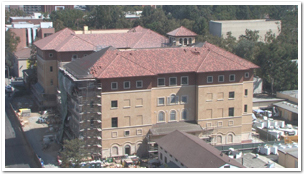
The Process
A few of the secrets to CAP’s success,
 The Constructability Review is not a new term in the Construction Industry, but CAP has given the Constructability Review a new meaning!
The Constructability Review is not a new term in the Construction Industry, but CAP has given the Constructability Review a new meaning!
The definition of a Constructability Review has been widely known in the industry as “a review and analysis of the contents of the construction documents”. CAP has taken the Constructability Review to a new level, as we do not simply review and analyze the contents of the construction documents. We review and analyze the entire construction process! Beyond reviewing the contents of the documents we analyze and report upon what is missing from the documents, as well as how alternative means, methods and materials will bring about cost savings, added long term value and efficiency in construction.
We would like to share with you some various examples to illustrate the experience, intelligence and creativity that made CAP the premiere player in our industry.

- 1.RFI’s and Potential Change Orders,
- a) The first step in our process is an extensive site review. We will spend 1-2 days on site reviewing the civil drawings, shoring and/or underpinning situations, utility locations and routes, local traffic issues and how the project will ‘fit’ into the lot. We confirm the exterior building doors will properly align with the exterior grades. Our experience constructing projects in densely populated urban environments has taught us which clues to look for to discover the “unforeseen” conditions prior to beginning the underground utility work.
- b) A comparison of the Architectural to Structural drawings is very important. We check to confirm the structural baseplates will fit within the building walls. We confirm deep structural beams will not interfere with the ceiling heights, recessed lighting layout or diffuser locations. We review all conditions which the Architectural drawings note to “see structural drawings (SSD) for details” and confirm the structural details both exist and will adequately work with respect to the Architectural intent.
- c) A thorough review of the Mechanical Drawings following each major duct route to assure they will fit in all tight areas clearing above ceilings, above recessed lighting and below structural beams. We not only double check the FSD locations, but also confirm the electrical drawings have picked up the power to the FSD’s.
- d) During our step by step walk through the entire construction process we review the structural requirements of the various finish components. We confirm the TS jambs and headers are not only shown on the architecturals, but also detailed on the structurals. We confirm the architecturals indicate structural steel supports for ceiling hung toilet partitions. We double check TS posts are called out in the low height partition walls. We confirm the baseplates and other structural connections fit within the confines of the walls. We review the panels, shelving and other components hung on the walls and identify areas where studs, particularly in non-load bearing walls, may be overloaded.
 click here to view a sample RFI & Potential Change Order Analysis
click here to view a sample RFI & Potential Change Order Analysis
- 2. Waterproofing Issues,
- a) A comprehensive review to assure every point of the building has both a primary and a secondary waterproofing barrier. An extensive review of the joints between skin components and especially the corner conditions. We not only confirm that flashing is indicated at all head and base conditions, but will comment on alternative flashing methods to present cleaner finished appearance. (Examples of our alternative flashing methods are available upon request.)
- b) We review the structure to assure misc. steel components are either present or clearly identified to be by the Design/Builder. Responsibility for misc. steel has historically been the cause of many disagreements in the construction industry, which is why CAP places a significant emphasis on identifying and quantifying these components prior to execution of the prime agreement.
- c) We review how each different attachment point for each different skin component will penetrate the building envelope and be properly waterproofed.
- d) Particularly important for construction below the water table, we review the below grade penetrations for the electrical and other utility services to assure proper waterproofing details have been provided. Specifically, electrical service conduits often must enter the building in tight clusters, which is not an acceptable condition for a below grade waterproofing system.
- e) We review the roof penetrations to assure structural drawings call for either pipe or TS supports where penetrating the roof, as angles, wide flange beams/columns and other odd shaped members cannot be properly waterproofed. We assure MEP roof supports are not designed such that unistrut will penetrate the roofing membrane. When a roofing system that requires lead roof jacks is specified we assure the MEP drawings properly call out lead, not galvanized, roof jacks.
- f) We provide alternative construction methods to avoid pitch pockets in ALL cases. Pitch pockets will never be a method of waterproofing suggested by CAP.
- g) We’ll identify potential problems, such as the necessity to complete all caulking and sealants prior to applying water repellants to the exterior, as the caulking and sealants won’t stick to a surface coated with water repellants.
 click here to view a sample Waterproofing Analysis
click here to view a sample Waterproofing Analysis
- 3. Value Engineering,
- a) CAP does not approach Value Engineering simply as an exercise in cutting costs by cutting items out of the documents. First and foremost CAP approaches Value Engineering from the perspective of reducing costs without reducing the Architectural intent of the project. Further, CAP takes into account the long term use of the building during this process, we don’t forget about the maintenance costs resultant of decisions made during design and construction.
- b) CAP approaches the Value Engineering effort as a complete team effort. We pursue Value Engineering as a full partnership with the Owner and the Architect.
- c) We review the complexity of the exterior skin and work with the Architect to design the building envelope in the most efficient and economical method possible.
- d) CAP will suggest alternative materials for the interior and exterior finishes for review/discussion with the Owner and Architect.
 click here to view a sample Value Engineering Analysis
click here to view a sample Value Engineering Analysis
- 4. General Document Comments,
- a) Through our review we will make note of incorrect detail references, minor dimensional busts, spelling errors and other small items that are not likely to have a cost impact, but nevertheless should be cleaned up prior to issuance of the contract documents to the bidding community.
 click here to view a sample General Document Comments Analysis
click here to view a sample General Document Comments Analysis
- 5. Bid Scope Comments & Suggestions,
- a) We make note of general items often missed during the bidding period, thus causing hits to the Prime Contractors Contingency and eventual bottom line of the total project cost. Such as touch-up painting of the structural steel is typically excluded by both the Steel and Painting Subs, the Glass subs often exclude mirrors, the Framing and Misc. Metals Subs often both exclude the low height wall posts, the small note on the drawing indicating fire treated plywood backboards in the tele/data closets is often overlooked by all. CAP keeps a database on these items and runs through our checklist of common scope busts for each and every project.
- b) During our review of the specifications we will identify potential issues such as a caulking spec that calls for “standard or special colors as determined by the Architect”. In this example CAP will request the Architect remove this cost variable by specifying either standard or special colors to assure the bidders have a firm product cost to base their firm project bid upon.
- c) We identify and list the small items often missed during the often frantic and fast pace of a competitive bid environment. Such as the knox box at the front door, the floor safe in the accounting managers office, the magazine stand in the reception area, security bars directly below the AHU’s in the supply and return ducts, etc.
- d) We’ll make suggestions such as including costs to place a mud slab at the base of the excavation, include patching of the adjacent roads as the construction damage will likely be cause for this. Include block outs and patching in the Concrete, Waterproofing and Rebar Subs scopes that will be required to detension the tie-backs.
 click here to view a sample Bid Scope Comments and Suggestions Analysis
click here to view a sample Bid Scope Comments and Suggestions Analysis
- 6. Backing, Embeds and Long Lead Items,
- a) We’ll identify and list the backing required for the project, including the often missed backing for large signage, speakers, wall mounted projection screens and reglets at the roof parapet. As well as all Owner provided furniture, fixtures and equipment (FF&E) that can be found in the contract documents. Quite often the Owner’s plan for FF&E is not finalized until the near end of the project, therefore CAP will suggest a backing plan be prepared that takes into account multiple potential layouts. In the grand scheme of things backing costs next to nothing to install during the framing activities, but a lack of adequate wall support can be quite troublesome at the end of the project as the new occupants are moving in.
- b) We’ll identify and list the embeds required for the project, including the often missed misc. small embeds and block outs for items such as recessed floor mounted door closures, anchor bolts for Owner furnished equipment, studded base plates for welded bollards and corner guards cast into the concrete columns.
- c) We’ll list the long lead items for the project and point out critical procurement problems such as waiting for last minute field measurements or awaiting the work of other trades. Example, storefront doors often take 16-20 weeks to procure, which in and of itself is fine. But, the predecessors to ordering these doors include: procuring the door hardware submittal, submitting, returning to the Sub for corrections, resubmitting, returning to the sub to place the order, procuring the long lead door hardware, then providing the door hardware to the storefront door manufacturer in order for the clock to begin ticking on the 16-20 week lead time for storefront door procurement. In this example a simple 16-20 week lead time has been determined to take 7-8 months for the full process.
 click here to view a sample Backing, Embeds and Long Lead Items Analysis
click here to view a sample Backing, Embeds and Long Lead Items Analysis
